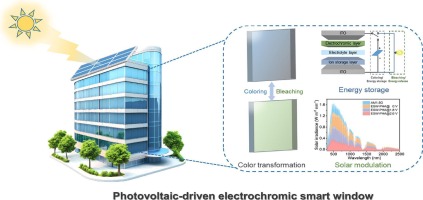The rapid development of human society is accompanied by increasing energy consumption, which exacerbates existing environmental problems. Building energy consumption accounts for a significant portion – approximately 40% – of global energy consumption, with heating, ventilation and air conditioning (HVAC) systems accounting for a significant share [[1], [2], [3], [4], [5], [6]]. While reliance on energy-intensive HVAC systems results in significant carbon dioxide emissions. Windows act as interfaces between indoor and outdoor environments and are the main channels for light and heat transfer [[7], [8], [9], [10]]. Conventional windows have limited thermal resistance and cannot selectively control the transmission of visible and near-infrared solar radiation. Therefore, optimizing window performance is essential to ensure energy efficiency in buildings and reduce associated environmental impacts [[11], [12], [13], [14]].
This impetus to reduce energy consumption has spurred the development of smart window technology, a significant advance in energy-efficient buildings [[15], [16], [17]]. Smart windows dynamically regulate solar transmittance and modulate light and heat indoors, effectively reducing energy consumption and mitigating greenhouse gas emissions [[18], [19], [20], [21], [22], [23]]. Electrochromic technology has attracted great interest in the field of smart windows due to its comparatively fast response kinetics, ease of control, and intrinsic bistability. [[24], [25], [26], [27], [28], [29]]. As a result, electrochromic smart windows (ESWs) are increasingly being implemented in contemporary building designs. During the electrochromic process, electrode materials undergo a reversible redox transition, which leads to color changing behavior and enables on-demand optical/thermal modulation. Therefore, color switching in electrochromic materials fundamentally depends on energy transfer processes: the oxidative process corresponds to a charging mechanism, while the reductive process represents a discharging mechanism. Consequently, ESWs represent a promising class of bifunctional platforms capable of integrating transmission modulation and energy storage through reversible redox reactions [[30], [31], [32], [33], [34], [35], [36], [37], [38], [39]]. However, the reliance of electrochromic smart windows on electrical energy for operation represents a persistent barrier to achieving net-zero energy building status and highlights the need for the development of truly energy-free electrochromic smart window systems.
To address this problem, several energy-free electrochromic smart window systems have been proposed. Nanogenerators (NGs), valued for their cost-effectiveness and practicality, are increasingly being integrated into electrochromic devices to develop self-sustaining systems [40,41]. Piezoelectric nanogenerators, triboelectric nanogenerators (TENGs), and their hybrid configurations are used to harvest ambient microenergy and convert it into electrical current, which then powers the electrochromic devices [42,43]. Nevertheless, reported NG-driven electrochromic integrated devices generally exhibit slow color conversion speeds, mainly due to the inherently low output power of NGs. While significant research efforts have focused on improving the output performance of NGs, the operational speed of these integrated systems remains a limiting factor that prevents them from achieving the performance benchmarks required for practical smart window applications. Recently, self-powered photoelectrochromic devices (PECD) integrating solar cells and electrochromic smart windows have emerged as a promising alternative to significantly reduce energy consumption in building HVAC systems. In addition, this photovoltaic-electrochromic integration technology is highly compatible with building-integrated applications due to its versatility [[44], [45], [46]]. In the PECD research landscape, the most common approach is to combine these integrated devices with dye-sensitized solar cells. As a result, a number of design strategies have been developed to create integrated devices containing both sensitized solar cells and electrochromic components. These strategies focus on how to utilize the photosensitive layer and the electrochromic layer within the same device [[47], [48], [49], [50], [51], [52]]. However, the practical implementation and commercialization of these integrated PECD architectures in the market is currently hindered by their complex structures and complicated manufacturing processes, which prevent them from meeting the requirements of widespread adoption.
In this study, we present a self-sufficient building energy system that uses a split design strategy for synergistic integration. This system combines electrochromic smart windows ESWs with photovoltaic technology (silicon solar cells) to reduce energy consumption. It offers a promising solution that addresses the current limitations of integrated monolithic PECDs in terms of practicality and marketability arising from their complex manufacturing. First, a new hyperbranched polyamide was designed and synthesized to construct ESW using a zinc frame counter electrode. The incorporation of hyperbranched architecture and amide bonds gives PHA excellent processability and electrochemical durability. This loosely hyperbranched structure is thought to increase the specific surface area, thereby increasing electroactivity and energy storage capacity. This structure also facilitates the solution processability of PHA, which is advantageous in practical applications. The resulting ESW-PHA device exhibits exceptional bifunctional performance of electrochromism (ΔT of 67.83% and 65.11% at 700 nm and 1200 nm, respectively) and energy storage capacity (2.6 V voltage window and 127.10 mF cm).−2 area-specific capacity). Computer-based energy simulations predict potential annual energy savings of 318.4 MJ m−2 per year (approx. 18.1% of total consumption) for buildings that use ESW-PHA to modulate the indoor climate. Significantly, the seamless integration of the ESW-PHA with photovoltaics enables a verifiably net-zero energy building while improving energy reuse to power household appliances. This comprehensive approach is instrumental in advancing sustainable energy solutions and creating a greener future.
